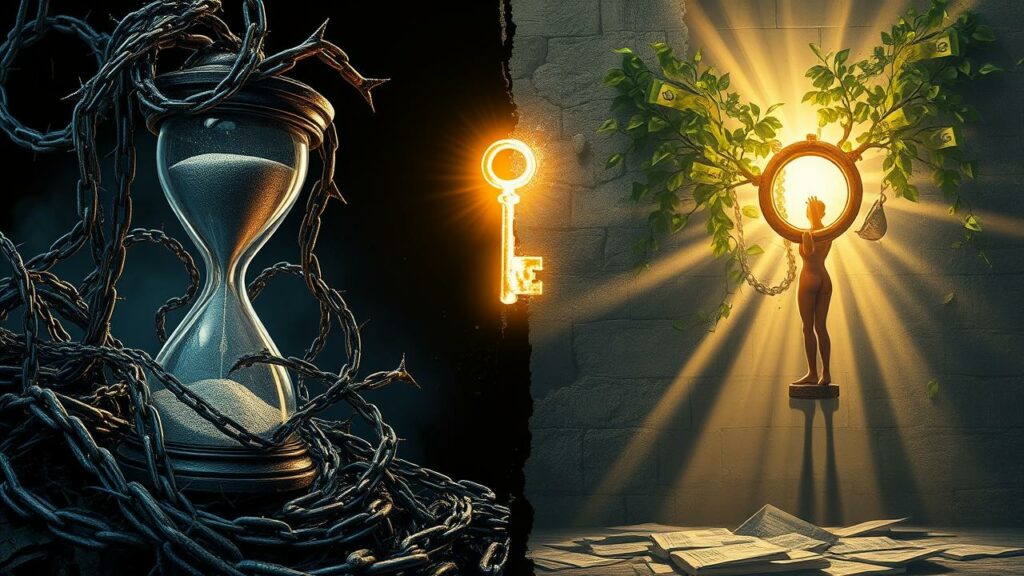The Weight of a Whisper
It starts with a quiet hum in the back of your skull. A low thrum of anxiety that follows you from the moment your alarm shrieks you awake to the exhausted hours before a fitful sleep. It’s the ghost of a purchase, the specter of a loan, the cold certainty that the numbers on a screen own a piece of your future. This is the raw, visceral truth at the heart of the bad debt vs good debt debate—it isn’t just about money. It’s about freedom.
Debt can be a key that unlocks a new life, a powerful engine for a business, the foundation of a home. Or it can be a cage. A slow, suffocating vine of high-interest payments and depreciating assets that tightens its grip with every swipe of a card, until you can barely breathe. One builds empires. The other builds prisons of your own making.
Forget the dry, academic definitions for a moment. Feel the difference. One is the thrill of a calculated risk paying off. The other is the sickening drop in your stomach when you realize you’re in too deep. The challenge isn’t just knowing the difference; it’s summoning the warrior within to destroy one and master the other.
The Unvarnished Truth
You want the bottom line? Here it is. Good debt is a strategic investment. It’s borrowing money to acquire something that will grow in value or generate income—a business, a property, an education that dramatically increases your earning potential. It’s leverage.
Bad debt is a trap. It’s borrowing for things that lose value the second you acquire them—fancy dinners, fast fashion, high-end electronics financed at 24% APR. It’s paying for yesterday’s desires with tomorrow’s potential. It consumes your income and devours your spirit.
The Alchemist’s Tool: Forging Wealth from Obligation
The air in the workshop was thick with the scent of hot steel and pine sawdust, a perfume of pure creation. Out in the yard, finished sculptures—twisted, elegant forms of metal and reclaimed wood—were starting to crowd out the remaining space. His order book was full for six months, but his tools were old, his workspace cramped. He was at a ceiling, a hard limit he couldn’t break through with sheer will alone.
Franklin stood there, the bank’s business loan offer a heavy weight in his hand, feeling the familiar knot of fear. Debt. The word itself tasted like failure. But this wasn’t for a vacation or a new truck. This was for a larger space, a plasma cutter that could do in minutes what took him hours, and the ability to hire an apprentice. It was a calculated risk to pour gasoline on a fire that was already burning bright. This was debt as a tool, not a shackle. It was a bridge to a bigger future, and he was ready to run across it.
The Quicksand of “Just This Once”
The stale smell of lukewarm coffee and air freshener clung to the upholstery of the car she practically lived in. Outside, the city lights blurred into a watercolor of exhaustion. Another night of driving strangers from one brightly lit box to another, chasing a flickering goal on an app that always seemed just out of reach. The “check engine” light had been on for a week, a small, amber god of doom she prayed to every morning, hoping it wouldn’t demand a sacrifice she couldn’t afford.
Lyla pulled into the gas station, her stomach twisting. The credit card felt like a hot coal in her hand. It started with a tire repair. Then it was for groceries when a fare didn’t pay. Then “just a little something” to feel human for a night. Now, it was a beast with its own life, the interest compounding in the dark, silent and monstrous. Every statement was a fresh horror. This was bad debt in its most brutal form—a series of small surrenders that had cascaded into an all-out siege on her life. The goal was no longer to get ahead; the goal was simply to survive the month.
Clarity in a World of Noise
Sometimes the battlefield is so chaotic you can’t tell friend from foe. Distilling the core principles can be the most powerful move you make. You don’t need a four-hour lecture; you need a moment of piercing clarity to reset your focus. This short breakdown from Fidelity does exactly that, cutting through the noise to give you the essential framework.
When the Investment Becomes an Anchor
The drone of the office was a constant, low-grade hum, the flicker of fluorescent lights a metronome marking time in a life he hadn’t chosen. He stared at the spreadsheet, columns of data blurring together, his mind a million miles away in a sun-drenched university library, full of philosophical debates and the intoxicating promise of a life of the mind. That promise had cost six figures.
Raymond had been told his student loans were “good debt.” An investment in himself. But the niche Master’s degree in post-war existentialist literature hadn’t exactly made him a hot commodity in the job market. Now, a decade later, the loan was a cold, hard anchor chained to his ankle. Each monthly payment was a bitter reminder of a dream that had curdled into a financial nightmare. The “investment” hadn’t generated a return; it had simply become a tax on his real life, dictating where he could live, what he could afford, and how much of his soul he had to trade for a steady paycheck.
The Uprising: Your War Against the Numbers
A day comes when the pain of staying the same becomes greater than the pain of changing. That is the day you stop being a victim and start being a warrior. The statements pile up, the phone calls from unknown numbers escalate, and the fear becomes a physical presence in the room. Good. Use it. Let that fury become the fuel for your uprising.
Your first move is to face the enemy. Spread every bill, every statement, every loan document out before you. Look at the numbers. All of them. This is not an act of self-flagellation; it is an act of power. You cannot defeat an enemy you do not understand. There are proven battle plans to get out of debt. For some, the psychological win of paying off the smallest balance first—the debt snowball method—is the key to building momentum. For others, the mathematically superior approach of attacking the highest-interest debt first—the debt avalanche method—is the only logical path. Deciding which of these debt elimination strategies works for your mindset is your next command decision.
The goal is to methodically and ruthlessly pay off credit card debt and other toxic obligations. This isn’t a passive wish; it’s an active, relentless campaign.
Beyond Zero: Rewriting Your Financial Story
Winning the war against bad debt is a monumental achievement, but the peace must be secured. The work isn’t over when you hit a zero balance; that’s when the real work begins. It’s time to rebuild. It’s time to change your relationship with money and credit forever.
This phase may involve difficult choices. Sometimes, a temporary strategic retreat is the smartest move. Pursuing a debt management plan through a reputable agency isn’t an admission of defeat; it’s a way to consolidate your forces and negotiate better terms of engagement. Some situations, especially when dealing with multiple high-interest cards, might benefit from a focused effort to consolidate credit card debt into a single, lower-interest loan. For others, exploring debt relief programs or even debt settlement might be the scorched-earth tactic needed to clear the field and start again. There is no shame in seeking guidance from professional credit counseling services; it is a sign of strength to admit you need a better map.
The Master’s Game: Wielding Debt by Design
Once you’ve escaped the prison of bad debt, you can finally learn to use the master’s tools. Good debt, wielded by a disciplined and educated mind, is one of the most powerful forces for wealth creation on the planet. This is the art of leverage—using other people’s money to acquire assets that work for you.
This is where debt becomes a crucial component of your financial independence roadmap. It’s securing a mortgage for a property that not only appreciates but generates rental income. It’s Franklin, using his business loan to scale production and multiply his profits. It’s about understanding that the interest you pay on the loan is less than the return you expect from the asset. This requires intelligence, nerve, and a meticulous understanding of your numbers. This is no longer about survival; this is about deliberate, strategic conquest.
Your Arsenal for the Fight
Sheer willpower is essential, but a warrior needs weapons. In the fight for financial freedom, your weapons are information and control. You need tools that give you a crystal-clear picture of the battlefield.
- Budgeting Apps (YNAB, Mint, etc.): You must give every dollar a job. These apps force you to confront your spending in real-time, eliminating the “death by a thousand cuts” from mindless purchases. They are your intelligence officers, showing you exactly where your money is going.
- Debt Payoff Calculator: This is your oracle. Plug in your balances and interest rates, and it will show you the future. It will calculate how quickly you can be free using different strategies and how much interest you’ll save. Seeing that end date—that freedom date—can be the single most powerful motivator you have.
Manuals for the Uprising
The right words can detonate old beliefs and forge new realities. These books are not just reading material; they are strategic manuals for transforming your entire relationship with money and debt.
Debt Free For Life by David Bach: This isn’t just a plan; it’s a battle cry. Bach provides a systematic, no-excuses framework for destroying your debt, turning the overwhelming into the achievable.
The Value of Debt in Building Wealth by Thomas J. Anderson: Once you’ve won the war on bad debt, this book teaches you the art of wielding good debt. It reframes debt from an enemy to a powerful, strategic ally in the quest for wealth.
Debt 101 by Michele Cagan: Consider this your foundational field guide. It demystifies everything from credit scores to payoff strategies, giving you the core knowledge you need to navigate the complex world of debt with confidence.
Dispatches from the Front Lines
What is the real, human difference in the bad debt vs good debt struggle?
Forget spreadsheets. The difference is what you feel in your gut. Good debt feels like nervous excitement—the risk of taking on a mortgage for a home where your kids will grow up, or a loan for a business you believe in. Bad debt feels like dread. It’s the anxiety of using a credit card for takeout because your paycheck is already gone, knowing you’re digging the hole deeper. One is a calculated step toward a dream; the other is a desperate grab to delay a nightmare.
Why do some wealthy people claim all debt is good?
Because they are playing a different game. For them, debt isn’t about survival; it’s about leverage. A millionaire might borrow $800,000 against a property at 6% interest because they know the asset will generate an 11% return through rent and appreciation. They are making money on the bank’s money. It’s a powerful strategy, but it’s one you can only play after you have annihilated your high-interest consumer debt and built a solid financial foundation. Using their logic to justify your car payment is a rookie mistake.
My student loan was supposed to be “good debt,” but it feels like an anchor. What went wrong?
You’re not alone. This is the story of Raymond and countless others. The “good debt” label on student loans comes with a huge asterisk. It’s only good if the education leads to a significant increase in income that easily covers the cost of the loan. When the return on investment doesn’t materialize, it becomes one of the most insidious forms of bad debt—a massive obligation with no corresponding asset or income stream. The path forward involves treating it like any other debt: attack it aggressively, explore income-based repayment options, and never let the “good debt” myth prevent you from seeing it for what it is—a barrier to your freedom.
Maps for the Road Less Traveled
Your education doesn’t stop here. Continuously arm yourself with knowledge. These resources offer deeper dives and diverse perspectives on your journey to financial power.
- Good Debt vs. Bad Debt (Experian)
- Debt Management Guide (Investopedia)
- Financial Leverage: Good vs. Bad Debt (U.S. Bank)
- r/personalfinance: A massive community sharing strategies and support.
- r/Debt: A focused forum for those actively fighting to get out of debt.
Choose Your Path
The war over bad debt vs good debt is not fought on grand battlefields. It is won or lost in the quiet moments of decision. The choice to brew coffee at home instead of buying it. The choice to put an extra $20 on a credit card bill. The choice to face a statement you’ve been ignoring.
You hold the power to change your reality. Not overnight. Not without a fight. But absolutely, unequivocally, you can win. Don’t try to conquer the whole mountain today. Just take the first step. Pick one thing. Calculate your total debt. Choose your repayment strategy. Make one cut to your budget. That single act of defiance is where your new life begins. Start now.







